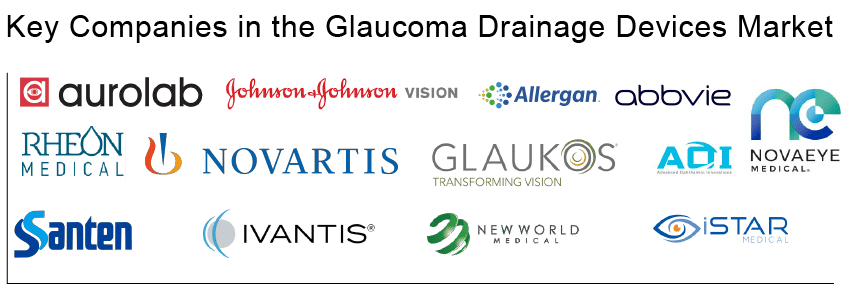Prominent Players in Glaucoma Drainage Devices Market
Apr 15, 2022
Table of Contents
Glaucoma is a group of progressive optic neuropathy which is characterized by the degradation of ganglion cells present in the retina. The loss of the retinal ganglion is associated with intraocular pressure (IOP), an elevated IOP due to an imbalance in the production and drainage of aqueous humor that might lead to structural changes in the lamina cribrosa (a mesh-like structure at the optic nerve head that surrounds and supports the retinal ganglion cell axons as they form the optic nerve). This further causes impairment in the signal transmission by the axons through the optic nerve fibers leading to progressive damage in the visual field. Apart from increased IOP, low perfusion pressure, and/or low cerebrospinal fluid pressure also raise the gradient across the lamina cribrosa and damage the vision. Glaucoma is one of the leading causes of irreversible vision loss across the globe. The Glaucoma diagnosis is frequently delayed because it might be asymptomatic until the late stage.
Different types of glaucoma are categorized based on respective structural changes in the anterior segment of the eye. The two major types of glaucoma are Open-angle glaucoma and Angle-closure glaucoma (also referred to as “closed-angle glaucoma” or “narrow-angle glaucoma”). The other complicated glaucomas are uveitic glaucoma, neovascular glaucoma, and pediatric and developmental glaucomas, among others. The disease is treated by lowering the eye pressure (intraocular pressure). Depending on the situation, the options for Glaucoma treatment comprise prescription eye drops, oral medications, laser treatment for glaucoma, surgery, or a combination of any of these.
Downloads
Click Here To Get the Article in PDF
Recent Articles
- Aktis’s Novel Targeted Alpha Radiopharmaceuticals; Koye Partners with Sonde Health; Novartis to S...
- Insights Into the Evolving Landscape of the Ocular Implants Market
- The Unmet Needs in Glaucoma Treatment: Bridging Gaps for Better Vision Care
- Vivos Therapeutics ‘s DNA Oral Appliance for the Treatment of OSA; Arthrex’s TightRope Implant fo...
- Rapid Medical’s TIGERTRIEVER 13; Glaukos’s Istent Infinite System; GE Healthcare’s Definium 656 H...
When the Glaucoma medicines and eye drops could not improve the condition, Glaucoma surgery is recommended. There are different surgeries which include conventional filtration surgeries such as trabeculectomy, glaucoma implant surgery, and recently emerged minimally invasive glaucoma surgery (MIGS).
Glaucoma Drainage Devices & its Types
Glaucoma drainage devices used in glaucoma surgery are designed to reduce intraocular pressure (IOP) by diverting the aqueous humor to an external reservoir from the anterior chamber. Several of the currently available glaucoma drainage devices in the market include conventional aqueous shunts (tube-plate design) and more recent implants, such as the EX-PRESS® Glaucoma Filtration Device and the new MIGS devices.
Conventional Glaucoma Drainage Devices
Conventional glaucoma implants are the traditional aqueous shunts that drain the aqueous humor with the help of a tube inserted into the anterior chamber to a sub-Tenon’s endplate by creating a more posteriorly located bleb. Depending on the presence of a valve mechanism, these implants are categorized into two types valved (flow-restricted) or non-valved devices.
Valved implants allow only unidirectional flow from the anterior chamber to the subconjunctival space with a minimum opening pressure whereas non-valved devices drain aqueous humor from the anterior chamber through an open, unobstructed tube. Some of the commercially available aqueous shunts include the Molteno® (NOAEYE Medical), Baerveldt® (Johnson & Johnson Vision), PAUL® implants (Advanced Ophthalmic Innovations), Ahmed® Glaucoma Valve (New World Medical), and Ahmed® ClearPath (New World Medical).
EX-PRESS® (Trabeculectomy-modifying device)
EX-PRESS® was designed to offer a safe and simple alternative to the classic trabeculectomy. This glaucoma filtration device is a miniature, tube-like implant made of medical-grade stainless steel. The glaucoma surgery with the EX-PRESS device lowered the IOP similar to that of trabeculectomy.
Minimally invasive glaucoma surgery (MIGS) devices
According to the Food and Drug Administration (FDA), MIGS devices are defined as “a type of IOP-lowering device used to lower IOP using an outflow mechanism with either an ab interno or ab externo approach, associated with little or no scleral dissection and minimal or no conjunctival manipulation”. Whereas, as per the European Glaucoma Society Guidelines, only the ab interno non-bleb-forming procedures can be defined as MIGS.
Based on the site of anatomical intervention and augmentation MIGS devices are sub-classified into three main categories: schlemm’s canal MIGS devices, suprachoroidal MIGS devices, and subconjunctival MIGS devices.
Factors Strengthening the Glaucoma Drainage Devices MarketThe growing burden of glaucoma across the globe is the predominant factor responsible for an increased demand for glaucoma drainage devices, worldwide. For instance, according to the World Glaucoma Association 2022, globally, an estimated 80 million people were suffering from glaucoma in the year 2020. Additionally, the source also projected the number to increase to 111.8 million individuals in 2040. Furthermore, as per DelveInsight Glaucoma Epidemiology Forecast Report, the total diagnosed prevalent population of Glaucoma in the 7MM was more than 10 million in 2020, which is expected to increase in the forecast period. Among the 7MM, the US accounted the majority of the Glaucoma diagnosed prevalent cases in 2020.
- Furthermore, escalating aging population is also expected to contribute to the Glaucoma Drainage Devices market growth. This is because older age is not only a risk factor for developing glaucoma but also aids its progression. Various studies have demonstrated that the percentage of glaucoma patients dramatically increases with age. As per the World Population Ageing 2020 highlights published by the United Nations in the year 2020, about 727 million people aged 65 years and above across the globe which is projected to increase to over 1.5 billion by the year 2050. Thus, the rising old age population could potentially increase the likelihood of glaucoma among them thereby raising the demand for glaucoma drainage devices.
- In addition, the rising prevalence of lifestyle-associated disorders such as diabetes and hypertension among the population could augment the market for these devices as various studies have shown that an increase in diabetes or hypertension elevates the risk of developing glaucoma by many folds. According to the International Diabetes Federation (IDF) 2021 data, an estimated 537 million adults (20-79 years) were living with diabetes in the same year, and the number is projected to increase to 643 million by 2030 and 783 million by 2045. Additionally, as per the same source mentioned in the year 2020, an estimated 191 million people living with diabetes are estimated to develop diabetic retinopathy by 2030.
Moreover, the technological innovation in product development in glaucoma drainage devices will lead to an increase in the demand for these devices, thereby leading to the Glaucoma Drainage Devices market growth. For instance, in August 2019, New World Medical launched the newest addition to the company's trusted Ahmed® brand of drainage devices, “Ahmed ClearPath glaucoma drainage device”. One of the unique features of the Ahmed ClearPath implant is a flexible plate with a contour that closely conforms to the curvature of the eye. Therefore, such advancement might lead to an increase in the adoption of these devices and thus contributing to the market growth.
Key Five Players in the Glaucoma Drainage Devices Market
The Glaucoma Drainage Devices market is dominated by a few of the key manufacturers. Also, there exists a predominant competition between the market players regarding the development and marketing of new products. Currently, the Glaucoma companies are actively involved in newer and innovative methods for addressing certain post-operational surgical complications.
As per Delveinsight analysis in the report titled “Glaucoma Drainage Devices Market Insight Report”, the global key players in the market are as follows:

Johnson & Johnson Services, Inc. – New Jersey, United States
Johnson & Johnson Vision, a subsidiary of Johnson & Johnson Services, Inc. was established in the year 1996. The division is a part of the medical devices division of the parent company is dedicated to providing products ophthalmology-specific products ranging from surgical systems to contact lenses to intraocular lenses, glaucoma, and other implants.BAERVELDT® Glaucoma Implants are the key glaucoma drainage device in the company’s product portfolio.
Alcon Inc - Illinois, United States
With a 70-plus year heritage, Alcon is one of the largest eye care device companies in the world, dedicated to helping people see brilliantly since 1931. The company has the widest array of eye care offerings in the industry with products organized into two businesses: Surgical and Vision Care for the management of cataracts and refractive errors, like presbyopia and astigmatism, and ocular disease like dry eye, ocular allergies, among others.The company has EX-PRESS Glaucoma Filtration Device in its product portfolio for the treatment of glaucoma.
Glaukos Corporation - California, United States
Glaukos Corporation, founded in the year 1998, is a medical technology and pharmaceutical company primarily developing new therapies for the treatment of glaucoma, corneal disorders, and retinal diseases. The company is the pioneer in launching the Micro-Invasive Glaucoma Surgery (MIGS) based devices in the market for treating glaucoma. In 2012, the company launched its first MIGS device—the iStent®—in the United States, followed by other next-generation iStent inject® device in September 2018 and iStent inject® W in September 2020.
The product portfolio of the company is as follows:
AbbVie Inc. - Illinois, United States
Allergan, now a part of AbbVie Inc., markets a portfolio of leading brands and best-in-class products for the central nervous system, eye care, medical aesthetics and dermatology, gastroenterology, women's health, urology, and anti-infective therapeutic categories. The company has XEN® Gel Stent, the only FDA-cleared stent that creates a low-lying, ab interno bleb for effective intraocular pressure (IOP) reduction.
Santen Pharmaceutical Co., Ltd – Osaka, Japan
Santen Pharmaceutical Co., Ltd., established in the year 1980 is growing into a leading ophthalmic pharmaceutical company by selling its eye care products in more than 60 countries. The company collaborates closely with ophthalmic medical professionals for the development of innovative solutions and the advancement of the ophthalmic ecosystem.The company has PRESERFLO MicroShunt in its product arena for the treatment of glaucoma.
Recent Developments in the Glaucoma Drainage Devices Market
- In February 2022, Santen Pharmaceutical Co., Ltd. was granted the marketing authorization for the PRESERFLO MicroShunt Glaucoma Drainage System Core Kit, an intraocular drainage device.
- In May 2021, Glaukos Corporation entered into a new development and commercialization license agreement with Santen Pharmaceutical Co., Ltd. (Santen) for the PRESERFLO™ MicroShunt (development code: DE-128). The former company has also obtained exclusive commercialization rights for the MicroShunt in the United States, Australia, New Zealand, Canada, Brazil, Mexico, and the remainder of Latin America.
- In April 2020, Allergan Plc., now a subsidiary of AbbVie Inc., received product approval from China's National Medical Products Administration (NMPA) for XEN® Gel Stent for the surgical management of patients with refractory glaucoma through the Real World Evidence pathway.
Conclusion
Owing to the presence of some global and regional players worldwide, the Glaucoma Drainage Devices market is moderately competitive. The key Glaucoma companies offer a wide range of glaucoma drainage implants based on different technologies. Key players employed various strategic business activities such as partnerships, product launches, mergers, and acquisitions to hold their market position.
As per DelveInsight’s assumption the global Glaucoma Drainage Devices market is expected to rise at a constant growth rate during the forecasted period owing to the rise in the target population, the availability of a conducive environment for product development and launches, increase in strategic business activities by the key manufacturers for developing technologically advanced and innovative products, rise in product approvals, among others. For instance, in September 2021, Glaukos Corporation submitted a supplemental premarket approval application to the US Food and Drug Administration (FDA) for its iStent infinite Trabecular Micro-Bypass System. Additionally, an increase in programs to raise awareness regarding glaucoma management could also increase the adoption of glaucoma drainage implants. For instance, Santen Pharmaceuticals Ltd., along with a group of patient advocacy groups across Europe, is leading a multi-channel awareness campaign to encourage patients to prioritize their glaucoma during the pandemic. The first phase of activities reached millions of patients in France and other European countries through national and regional newspapers as well as through various digital channels.
In addition, budding stage companies investing in the development of advanced glaucoma drainage devices such as MicroOptx, AVISI TECHNOLOGIES INC., among others will also surge the market. For instance, Avisi Technologies Inc. is developing a next-generation aqueous shunt, VisiPlate, that aims to treat glaucoma. It leverages an ultrathin nanoplate that is designed to achieve unprecedented strength and flexibility for its scale. VisiPlate is 20x thinner than human hair. It has a unique multichannel design to create outflow redundancy, which may lead to sustained IOP control over time. The device is made of alumina and parylene-c, non-fibrotic materials that have the potential to reduce the risk of scarring and blockage. In September 2020, Avisi Technologies received a USD 1 million Small Business Innovation Research Phase II grant from the National Science Foundation (NSF) for preclinical work.
However, a few complications of glaucoma drainage devices are infection, conjunctival erosion, and others that are likely to impede the Glaucoma Drainage Devices market.

FAQs
Glaucoma is categorized based on the respective structural changes in the anterior segment of the eye. The two major types of glaucoma are Open-angle glaucoma and Angle-closure glaucoma.
The market offers various types of glaucoma drainage devices, including Conventional aqueous shunts, EX-PRESS® Glaucoma Filtration Device, and Minimally Invasive Glaucoma Surgery (MIGS) devices.
The leading glaucoma drainage device companies, such as Johnson & Johnson, AbbVie Inc., Alcon Inc., Glaukos Corporation, Santen Pharmaceutical Co., Ltd, NovaEye Medical Limited, iSTAR Medical SA, Rheon Medical SA, Advanced Ophthalmic Innovations Pte Ltd, New World Medical Inc., Aurolab, and others are currently active in the market.
The global glaucoma drainage devices market was valued at USD 640 million in 2024, growing at a CAGR of ~12% during the forecast period from 2024 to 2030, to reach USD 1.1 billion by 2032.
Downloads
Article in PDF
Recent Articles
- What can be the scope of Medical Marijuana?
- Annovis announces IPO results; Conatus merges with Histogen; Novartis discontinues its generic jo...
- Enovis Acquires Novastep; Rockwell Medical Announced Collaboration with B. Braun; Dexcom G7 Recei...
- Aktis’s Novel Targeted Alpha Radiopharmaceuticals; Koye Partners with Sonde Health; Novartis to S...
- Rapid Medical’s TIGERTRIEVER 13; Glaukos’s Istent Infinite System; GE Healthcare’s Definium 656 H...



